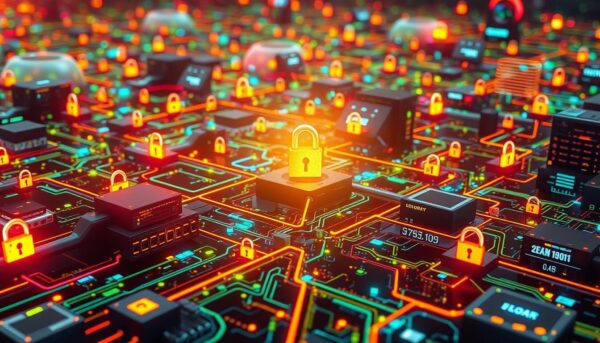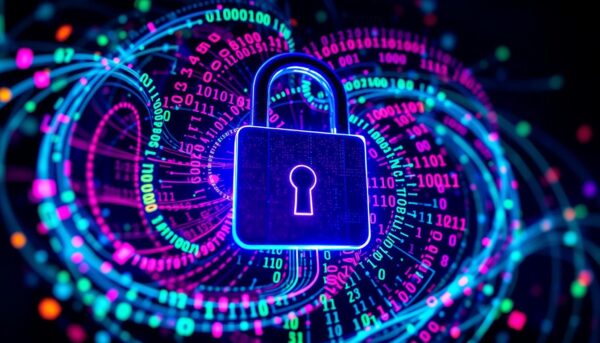✅ Last checked on
In today’s world, cyber threats are everywhere. Do you know some simple actions could risk your sensitive data? It’s key to know common cybersecurity mistakes to keep your network safe. Cyber breaches cost companies a lot of money each year, often due to simple oversights.
Not updating software and poor password management are big mistakes. These errors can harm both individuals and businesses. This article will cover common errors that risk your online security. We’ll also offer ways to improve your defense.
Key Takeaways
- Common cybersecurity mistakes can lead to significant financial losses for organizations.
- Implementing multi-factor authentication greatly enhances security.
- Regular software updates are vital for safeguarding against vulnerabilities.
- Employee training is crucial in preventing cyber scams like phishing.
- Using unique, strong passwords is essential for effective password management.
- Procrastinating on updates can leave systems exposed to cyber threats.
- Understanding and addressing third-party risks is critical in network security.
Understanding Network Security Mistakes
It’s key to know common cybersecurity errors to build a strong network security plan. Many cyber breaches lead to big financial losses. This is often because of simple mistakes. For example, weak passwords cause 81% of breaches, which is a big problem for small and medium-sized businesses.
With more people working from home, keeping digital practices safe is more important than ever. Making sure mobile devices are secure and teaching employees to use unique passwords helps prevent online threats. Leaving remote-access settings on can make your network vulnerable, especially if you haven’t changed your router’s default settings.
Phishing scams are a big problem, and not training employees well enough about them is a major issue. Good training programs can help create a culture of cybersecurity awareness. This can greatly reduce the risks from common cybersecurity mistakes.
Also, keeping your router’s firmware up to date is crucial for security. Updates can make your system run better and protect it from cyber threats. But, always back up your router settings before updating to avoid losing important settings.

| Common Cybersecurity Errors | Impact on Network Security | Recommended Safe Digital Practices |
|---|---|---|
| Weak Passwords | 81% of breaches | Use unique passwords for each account |
| Ignoring Updates | Increased vulnerability to attacks | Regularly update router firmware |
| Insufficient Employee Training | Higher risk of falling victim to phishing | Conduct frequent cybersecurity awareness sessions |
| Leaving Remote-Access Enabled | Potential exposure to breaches | Disable when not needed |
| Standard Router Settings | Vulnerable to exploitation | Change default configurations immediately |
The Importance of Unique Passwords
Password security is key to keeping your personal info and digital stuff safe. It’s important to use different passwords for all your accounts. If you use the same password everywhere, a hack on one account can put all your others at risk.
When a third-party site gets hacked, it can make things worse. This is because your passwords are linked across different platforms.
Risks of Password Reuse
Reusing passwords makes it easier for hackers to get into your other accounts. If they get into one, they can get into others too. Here are some risks:
- Easy access to multiple accounts if one password is compromised.
- Increased chance of identity theft and data breaches.
- Difficulty in tracking security breaches due to shared credentials.
Best Practices for Creating Strong Passwords
Creating strong passwords is crucial for online safety. Here are some tips:
- Use a mix of letters, numbers, and symbols.
- Make sure your passwords are at least 12 characters long.
- Use tools like Google Password Manager to keep your passwords safe.
- Try using passphrases instead of single words.
- Avoid common words and easy-to-guess phrases.
Following these tips can help protect you from password reuse. Also, turning on two-factor authentication adds extra security.

| Password Type | Characteristics | Security Level |
|---|---|---|
| Weak Password | Short, simple, or easily guessable | Low |
| Moderate Password | Contains numbers and symbols, but still predictable | Medium |
| Strong Password | At least 12 characters, random combination of letters, numbers, and symbols | High |
| Passphrase | A sequence of random words | Very High |
Neglecting Software Updates
Regular software updates are key to keeping your network safe. If you don’t update, your network can face many dangers. This includes security breaches and problems with how apps work.
Impact of Delaying Updates
Waiting to update your software makes it easy for hackers to find weaknesses. In fact, many data breaches happen because of outdated software. Cybercriminals are always looking for ways to get in, and outdated systems are prime targets.
Without updates, your systems might not work right. This can slow down your team’s work and cause big problems.
Automated Update Solutions
Using automated updates can really help keep your network safe. Android and ChromeOS offer updates that you don’t have to do yourself. This keeps your systems up to date with the latest security fixes.
Updating software regularly doesn’t just fix bugs. It also makes your systems run better. This helps prevent problems caused by old software.
| Risk Type | Description |
|---|---|
| Cybersecurity Vulnerabilities | Outdated software provides opportunities for cybercriminals to exploit weaknesses. |
| Ransomware Attacks | Failure to apply security patches increases the risk of ransomware incidents. |
| Application Malfunctions | Delaying updates may lead to software bugs causing disruptions in operation. |
| Incompatibility Issues | Older software can become incompatible with newer systems or apps, hampering productivity. |
| Performance Deterioration | Software rot can worsen over time, affecting the overall performance of systems. |
Overlooking Multi-Factor Authentication
Using multi-factor authentication (MFA) is key to better account protection. Many people and businesses miss this important step. It adds an extra layer of security, making it harder for hackers to get in.
By turning on 2-Step Verification, you protect your accounts from automated attacks. Even if hackers get your password, they still face more hurdles.
MFA can be set up in many ways, like getting codes via text or email, using an app, or getting a push notification. Google makes it easy, sometimes just needing to scan a QR code. These steps are crucial because old passwords are no longer safe.
Adding MFA helps keep your data safe, including when you access it remotely or check your email. It’s a smart move to keep your information secure.
Don’t ignore the importance of multi-factor authentication in your security plan. Weak passwords are a big reason for cyber breaches. With MFA, you make it harder for hackers to get in. This helps keep your online accounts safe in today’s world.